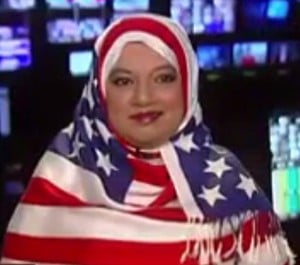Noorain Khan’s piece on bad burqa puns, which MMW reposted yesterday, came as I have been coincidentally trying to pull together an explanation of exactly what is wrong with headlines that use these puns. (For those unfamiliar with the structure, here’s an easy formula: “behind/beneath/under/beyond” +”the” + “veil/hijab/burqa/niqab.) Read her piece first for a great list of all the ways that this language plays out; what I want to do in this post is to expand on exactly what is wrong with using titles along these lines.
1. As Khan points out, this kind of headline is horribly uncreative and nauseatingly repetitive, described elsewhere as “a title that makes skins crawl among Muslim women the world around.” Even if this were the most brilliant, witty headline ever (which it isn’t; see below for why), it has been done so many times that I can’t imagine why no one has put a stop to it yet. If Khan’s piece linked above doesn’t give you enough examples, I’ve also written before about the many contexts in which it has been used:
To illustrate just how overdone this title is, a Google search of “behind the veil” (in quotes) gives about 569,000 results, including articles and books on women in Iran, “Western” journalists’ encounters with “women in conservative Islamic societies,” representations of Muslim women in Indian writings, an Australian woman’s experiences as a nurse in Saudi Arabia, prostitution in Iran, HIV/AIDS in Muslim countries, and even a BBC report from 2001 that also focused on Afghan women. The point is, it’s been done, ad nauseam, especially (but not exclusively) with regard to Muslim women, and “behind the veil” as a name is just plain lazy. Maybe that sounds harsh, but my frustration comes from having seen titles like this time and time again, and the implication that the only reason to pay attention to Muslim women is in order to de-veil them.
For another example, two separate articles about G. Willow Wilson’s new book, published in two different newspapers on the exact same day, used variations on this headline: a Boston Globe piece entitled “Beneath the Veil” and an article in the Daily Camera of Boulder, Colorado called “Under the Veil” (not available online.) Given the richness of Wilson’s writing and experiences, it’s disappointing at best that this title was the best that two different journalists could come up with.
2. It emphasizes the veil as a symbol of otherness, and its wearers as inherently different from the writer (as well as the writer’s imagined audience, who is presumed to be unveiled.) It also tells women who wear various forms of veils that they are inherently difficult, if not impossible, to understand, and that their veil is the main factor in any of their interactions with the non-veiled public.
3. It de-legitimizes the role of the veil as part of a woman’s experience. By assuming that we have to go “beyond” the veil in order to truly know someone, we are assuming that the veil exists only as a barrier to understanding a person’s identity, rather than a being a part of her identity that she is choosing to express. This isn’t to say that the veil is the be-all and end-all of a person’s identity, of course, but the assumption that we cannot properly know someone unless she is unveiled denies the possibility that understanding her relationship to the veil may actually be part of the process of knowing her.
4. Going behind the veil is invasive. Head and/or face coverings are often worn specifically to cover a part of the body that the wearers are choosing to keep out of the public eye. Claiming this right to go under the veil violates the decision that the wearer has made about which parts of her body are up for public viewing. We wouldn’t try to write an in-depth portrayal of someone entitled “behind the shirt” or “beneath the pants.” Let’s try to stay away from symbolic undressing altogether, okay?
5. There really isn’t anything all that interesting behind the veil anyway. You really want to know what’s behind it? Often there’s hair, there’s usually a head, and occasionally a face. It’s not that exciting. For those who were hoping that the veil was there to conceal superhuman beauty, Medusa-like snake hair, or secret alien antennae, I’m sorry to disappoint.











